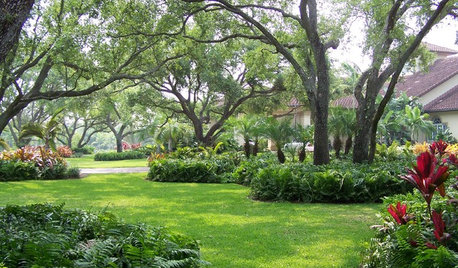Acer saccharum theory (Central Maryland)
hairmetal4ever
7 years ago
last modified: 7 years ago
Featured Answer
Sort by:Oldest
Comments (15)
edlincoln
7 years agoRelated Discussions
Central Florida Trees Dying
Comments (44)Please forgive my recent absence. Due to recent personal issues I've been been unable to participate and am now slowly trying to catch up on things. I still reject all ideas about chemicals, herbicides, salt water intrusion, etc. The distribution pattern does not correlate. To recap slightly, what I'm seeing (though I've not been out much lately) is vast normal areas of seemingly healthy trees in which one comes across single dead trees widely spaced--mostly oaks, but other species, too--and most alarmingly, groups (4-7) of dead trees. As anyone who lives around here knows, Oaks are the vast majority of existing trees in central Florida so it's no surprise that even if multiple species are uniformly affected, it would be Oaks that bear the brunt of the effect and suffer in greater numbers. (As soon as I get a chance I will try to make and post a video and will put a notice about it here.) Sometimes, the group will have other nearby individual dead trees very close around it... such as 4 adjacent dead trees, and within 500' of them, 4 or 5 more. Recently, of a group of a dozen or so palms, I noticed 3 adjacent ones, fresh dead. Another symptom that may or may not be related... I'm seeing many trees that from a distance look healthy, but have tip sections (approx. 3'-6') of branches that are flat dead. Some of these trees may have 3 such dead branches (as viewed from one side). Some may have a dozen. I'm in eastern Hillsborough County. Yesterday, I went to Brandon (a more urban/suburban area) and over there I did not see as many dead trees and dead branch tips. But there were some. Also, recently, I happened upon a land owner who was affected by dead trees so inquired as to what he knew. He was adamant that the death was caused by beetles. He claimed to obtain this information from someone who would know about such things, but our conversation was hectic as he was in the middle of work activity requiring his focus. And I had little time then, too, so was not able to get more information. However, I can believe that such a theory is far more likely than any chemical-based theory. I could imagine how beetles could move into an area and quickly distribute themselves on an adjacent group of trees. And on some other nearby trees. And then fly off to trees one-quarter mile away and do it all again. I can imagine, too, that they could do this in concert with some weather/climate phenomenon and seemingly "burst" upon the scene as a sudden catastrophe... such as the periodic "herds of locusts." They could do damage directly or be the carrier of disease a la the well known Dutch Elm Disease. However, I'm not in a position to research this information first-hand and there seems to be a lack of it coming through official channels. When I fist reported it here it was extremely new (to this area) so stood a good chance of not yet being noticed or having anyone ascertain its degree of impact. The overall distribution of this condition... what may or may not exist beyond my area, is unknown to me. Maybe we are the "epicenter." Or maybe this is just old stuff finally working its way through this area from other parts of Florida. I'm surprised that it is does not yet seem to be a major local news story or that definitive information is not coming forth via official channels. Then again, I've been out of commission for more than two weeks....See MoreFall color 2015 thread
Comments (137)One advantage of "Mexican Dogwood", Cornus florida subsp. urbiniana, besides the odd looking flowers: it is extremely late to color. Which, in my climate that seldom has a freeze before Thanksgiving, is OK. Other dogwoods have already dropped most of their leaves and this is just starting to color....See MoreFor the Love of Sugar Maple
Comments (32)We all been told if you dug up a tree the root system would be the same as the tree. Where most research doesn't go as the tree gets older it becomes more then one living tree..I'm putting this in simple terms! When it comes to tree care we can tell something is going on with the roots by canopy if there isn't pest/diseases playing a roll in it. If you prune to much roots on one side you'll see change in that side depending on how much was pruned. If you cut down a old growth tree an carefully remove wood you'll find the original sapling in the middle. I have done a lot of research on smaller trees to the point of splitting a tree following a root,sealing the wound to stop the tree from drying out. Whatever part I'd graft a root to the root system a new branch would start budding out on that side....See MoreFALL COLOR THREAD - 2017
Comments (150)Yeah the fall colors have not been as great in our area this year either. I assume it has something to do with the odd weather this summer. First too wet, then too dry, then an early cold snap followed by a lengthy warm period. I was just glad that our crab apple turned out as nice as it did....See Morekentrees12
7 years agoUser
7 years agolast modified: 7 years agowisconsitom
7 years agokentrees12
7 years agoSmivies (Ontario - 5b)
7 years agohairmetal4ever
7 years agoBulldog Climbing Service
7 years agowisconsitom
7 years agoUser
7 years agolast modified: 7 years agowisconsitom
7 years agobengz6westmd
7 years agolast modified: 7 years agoUser
7 years agolast modified: 7 years agobengz6westmd
7 years agolast modified: 7 years ago
Related Stories

GARDENING GUIDESAn All-Star List of 10 Shade Trees to Plant This Fall
These tried-and-true varieties offer good-sized canopies, seasonal interest, wildlife benefits and more
Full Story






wisconsitom